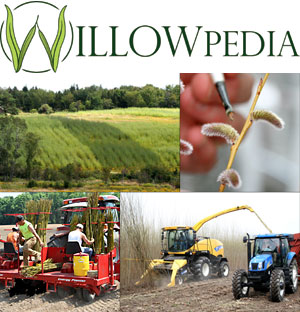 Willowpedia is a new website focusing on the study and commercial use of shrub willows as a sustainable feedstock crop for bioenergy, biofuels, and bioproducts, as well as for environmental engineering and horticultural applications.
Willowpedia is a new website focusing on the study and commercial use of shrub willows as a sustainable feedstock crop for bioenergy, biofuels, and bioproducts, as well as for environmental engineering and horticultural applications.
Shrub willows (Salix species that grow 15 to 25 feet tall) are ideally suited for bioenergy plantings on marginal farmland, particularly on soils where poor drainage makes planting agronomic crops difficult. Plantations are usually established by planting dormant stem cuttings or whips, available in New York from Double A Willow nursery. The multiple stems from each shrub can be harvested every three or four years for the life of the planting, usually 25 years or more.
Larry Smart, associate professor in Cornell University’s Department of Horticulture based at the New York State Agricultural Experiment Station in Geneva, has spearheaded the site’s development, which was initiated by Chris Cooley of CMC Creative Design and completed by Roxanne Li (’12) as a part of her internship funded by Cornell Cooperative Extension. The site currently focuses on Smart’s work and collaborations with researchers in Cornell’s Departments of Entomology, Plant Pathology and Plant-Microbe Biology, and Biological and Environmental Engineering. But Smart hopes that the site will grow to become a center for the global exchange of knowledge among the entire willow community and the public.
Currently the site includes:
- Summaries of on-going research, including cropping systems, breeding, pests, diseases and more.
- More resources including factsheets and a handbook for growers.
- News, FAQ, photo gallery, video and more.


